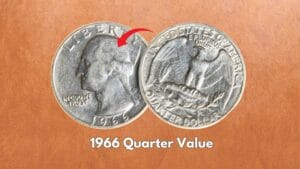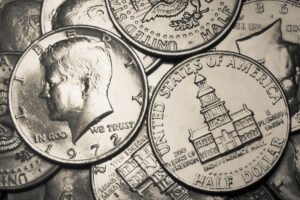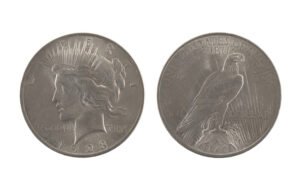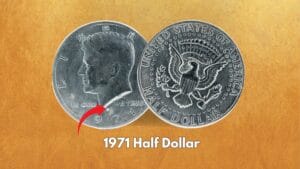Bidding farewell to its silver legacy and ushering in the copper-nickel-clad dynasty, the 1965 quarter marks an important turning point in American numismatic history.
Though less popular than the pre-1965 Silver Quarters, the 1965 Washington Quarters attract collectors’ eyes because of their unique errors, especially the transitional error. But do such errors and other features also hike the quarter’s value? Let’s find out!
Key Takeaways
- The 1965 Washington quarter is a deviation from the customary silver composition, which was issued due to the rising prices of silver.
- The 1965 quarters don’t display any mint marks for specific minting locations.
- A common, mint state 1965 Quarter doesn’t value more than a few dollars unless it has some errors.
- A 1965 error quarter coin with the DDO/DDR and Planchet errors can cost up to $2,000 – $3,000.
Interesting History of the 1965 Washington Quarter
Since its authorization in 1932, the Washington Quarter has undergone a rollercoaster of events to date:
- 1932: The Washington Quarter was issued to commemorate the first President of the USA, George Washington’s birth.
- 1932-1964: The quarter coins, with Washington’s left profile on the obverse and in-flight heraldic eagle on the reverse, were popular in circulation for their silver composition.
- 1965: Due to rising competition and rocketing silver prices, President Lyndon Johnson decided to stop the traditional silver quarters and dimes and switch to a copper-nickel clad.
- 1965-1997: The Washington Quarter with the new cupronickel clad and copper composition but the same customary design continued for 33 long years.
- 1999: The traditional Washington quarter was changed to 50 State quarters, which featured unique designs on the reverse for each of the 50 US states.
| 1965 Washington Quarter | Key Facts |
| Material (Composition) | 75% copper & 25% nickel (cupronickel for layers) and copper (for core) |
| Minting Location | Philadelphia, Denver, San Francisco |
| Year of Minting | 1965 |
| Weight | 5.67 g |
| Diameter | 24.26 mm |
| Thickness | 1.75 mm |
| Designer | John Flanagan |
| Face Value | $0.25 (25 cents) |
| Mint Marks | No Mintmarks |
| Total Mintage | 1,819,717,540 (All Mints) |

Design Features on the 1965 Quarter Coin
The original Washington Quarter was designed by US Mint sculptor John Flanagan in 1932. The 1965 Quarter bears the same coin design as follows:
1. 1965 Quarter Obverse Design:
The 1965 Washington Quarter obverse or heads will display the following design features:
- The bust-size left profile of George Washington
- The word “LIBERTY” inscribed above the head, along the upper edge
- The mint year “1965” relief-carved below the truncation line of the Washington cameo/profile
- The phrase “IN GOD WE TRUST” written in small font on the left (lower) side of the obverse
2. 1965 Quarter Reverse Design:
You’ll find the following design on the 1965 quarter reverse (tails):
- An eagle with spread-out wings facing left and holding a bundle of arrows in its claws
- Two olive branches tied together carved below the eagle
- Denomination “QUARTER DOLLAR” inscribed along the bottom edge of the reverse
- The country name “UNITED STATES OF AMERICA” written along the upper half edge
- The US motto, “E. PLURIBUS UNUM,” carved in a small font right above the eagle’s head
3. Coin Composition & Dimensions of the 1965 Quarter:
In 1965, the US Mint decided to change the original silver composition of the quarter coins to the cupronickel clad because of escalating prices of silver metal.
While the traditional Washington quarter had 90% silver and 10% copper, the new quarters were made of cupronickel (75% copper, 25% nickel) layers on a pure copper core. This mint has stuck with this cheaper composition to date!
The 1965 Washington Quarter bears a reeded design with 119 reeds around the edge. And with a 24.26 mm diameter and 1.75 mm thickness, this coin weighs around 5.7 grams.
4. Unique Identifying Mint Marks:

During 1965-1967, all the Washington quarters were struck without any special identifying mintmarks regardless of which mint they were minted at.
So, remember that you’ll not find any mint marks on the 1965 Washington Quarters. If you see one with a mark, it may be forged or counterfeit.
5 Factors That Affect the 1965 Washington Quarter Value
Let’s learn more about the factors that determine the final resale price of your old 1965 Quarter:
1. 1965 Quarter Mintage & Rarity
In the first year after Congress authorized the copper-nickel clad quarters, the total mintage of 1965 Washington quarters at all facilities was 1,819,717,540. Due to such high mintage and no unique identifying mint marks, 1965 quarters won’t value more than $1 even with high mint grades like 60.
2. Condition & Grading of 1965 Washington Quarter
Since the no-mint 1965 Washington Quarter coins are common and easily found, the average or even 60-65 grade mint state coins don’t fetch more than $50.
It’s only the 66 or high-grade mint 1965 quarters that can be priced at a hundred to a few thousand dollars. Let’s see how:
| Coin’s Condition | 1965 Washington Quarter Value (Estimated) |
| Good to Very Fine (VF20+) | Less than 30 cents |
| Extremely Fine (XF40) – Almost Uncirculated (AU50+) | Not more than 80 cents |
| Mint State (MS60 – 65) | $1 – $50 |
| MS 66+ | $20 – $2,500 |

3. 1965 SMS (Special Strike) Washington Quarter
In layman’s words, if your old 1965 quarter turns out to be an SMS variation, its value will instantly multiply. But what’s an SMS variation, you may ask?
Well, from 1965 to 1967, the US mints didn’t strike any official proof coins. Instead, they sold sets of special mint coins (SMS) with a shiny, proof-like appearance.
The 1965 SMS Washington Quarter can cost up to $2,600 or more for very high mint state and specimen state grades. Here’s how you can value SMS quarters:
| 1965 SMS Washington Quarter Grades | Estimated Price |
| Below SP60 | Less than $20 – $30 |
| SP60-SP65 | $20 – $50 |
| MS65+ | $15 – $200 |
| SP66 or more | $50 – $2,500 |
If you want to confirm whether your old 1965 Washington Quarter is an SMS coin, pay attention to the following visible features:
- A satin-like shiny finish
- A deep cameo contrast (the deeper the contrast between the field and profile, the higher the value)
- Visible mint & polishing lines on the surface
- Mint-like high reliefs
Get your coin graded by a trusted third-party coin grading service, such as PCGS, NGC, ICG, and ANACS. The grading makes SMS coins more valuable.
4. 1965 Silver Quarter – A Transitional Error

When a coin is struck on a previous year’s planchet, it’s called a transitional error.
Now, before 1965, the quarter coins were being struck on a 90% silver planchet. In 1965, the US Mint transitioned to the new cupronickel-clad planchets for quarters and dimes, but some silver planchets from 1964 were still available.
The makers accidentally struck the new 1965 Washington Quarters on these silver planchets and released them in circulation. Today these 1965 Silver Quarters are worth thousands of dollars.
In fact, a 1965 silver quarter can cost up to $4,000 even in an Extremely Fine state with an XF45 grade.
To know if your 1965 quarter is silver, weigh it (the silver coin will weigh around 6.25 grams) and check its edge (the silver coin edge is entirely silver).
5. 1965 Quarter Minting Errors
Like all other old coins, the 1965 quarters also went through some minting errors as follows, which makes these coins more valuable and, hence, more coveted!
- Planchet Errors: These 1965 error quarters are those that are mistakenly struck on a 1c, 5c, or 10c planchet, causing the outer design to get cut off. This error can skyrocket your 1965 Washington Quarter value from $200 (in AU state) to $5,000 (in high-grade mint state).
- Off-Center Strike: When the coin bank gets misplaced in the mint die, the result is an off-center design obverse & reverse design ranging from 1% to 90% offset. Depending on the coin’s condition, a 1965 Off-Center Quarter can cost from $50 – $500 or more.
- 1965 DDO or DDR Error: This error happens when the letter “O” in the “GOD” or the letter “R” in the word “LIBERTY” on the obverse are double-died. If your coin is a DDO/DDR error, you’ll find these two letters to be double-struck, bolder than the rest. The value of these error coins can range from $300 to $2,500 as per the grades.
- Broadstruck Error: When the coin planchet does not fit correctly in the retaining collar while striking, the broadstruck error happens. To spot this error, see if your 1965 quarter is flatter and wider than its original dimensions. Such coins may cost less, up to $500, even in a high-grade mint state.
How to Tell If A 1965 Quarter Is Silver?
Unlike a cupronickel 1965 Quarter, the 1965 Silver Washington Quarter will not have any copper (red-colored) on its edge. Besides, the silver quarter looks brighter and weighs around 6.25 grams.
Even after its high mintage and no unique marks, the 1965 Washington Quarter is sought-after by collectors for its valuable errors and SMS variations. And this guide is the one-stop solution for collectors like you. The 1944 Wheat Penny is also popular as a resumption of the series. Join me if you’re interested in its value & history!
Note: This article is intended for informational, educational, and entertainment purposes only. Some images are illustrative and may not represent actual brands, products, or related entities. All trademarks, product names, brand logos, packaging, and other intellectual property referenced remain the exclusive property of their respective owners. Any brand mentions or references are provided solely for descriptive and educational context and do not imply any formal or commercial association.










